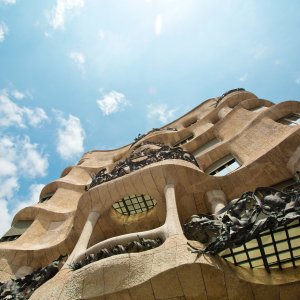Cultural and theatrical tourism: another way to do responsible tourism in Barcelona
Imagine for a moment immersing yourself in the local culture and tradition of a destination... that's what this type of tourism is all about. An endless number of activities with which to interact with the traditions, customs, gastronomy, language, cinema, music and ways of life of the local inhabitants. Don't miss our tips for your next cultural trip to Barcelona!

4 museums you should not miss on your visit to Barcelona!
The Museum of Contemporary Art of Barcelona
More commonly known as MACBA, this museum is located in Barcelona's Raval neighborhood as a beacon of creativity and modernity in the heart of the city. It was inaugurated in 1995 and designed by renowned architect Richard Meier; a museum that today not only houses an impressive collection of contemporary art dating back to the mid-20th century, but also offers a wide variety of temporary exhibitions and activities that inspire visitors of all ages. With its bright and open architecture, the MACBA is not only a place to admire art, but a dynamic space for meeting and learning, which stands out for maintaining good business practices.
Did you know that, since 2017, the company has had a sustainability strategy? Actions taken include: the definition of a responsible purchasing policy with suppliers, the implementation of an environmental management system, an Accessibility Plan supported by sponsors, a Visitor Experience Improvement Plan and the strengthening of relationships and actions with communities, especially with the artistic, educational and the Raval neighborhood.
The Center for Contemporary Culture of Barcelona
Popularly known as CCCB, this museum is located in the heart of Barcelona and has become a significant hub for innovation and cultural reflection over time. Established in 1994, the CCCB is an interdisciplinary organization offering a diverse program that includes exhibitions, debates, festivals, concerts, films, seminars, and workshops.
The Center for Contemporary Culture of Barcelona is committed to sustainability, implementing a range of initiatives aimed at minimizing its environmental impact and promoting responsible practices. These efforts include energy efficiency measures, the use of renewable energy sources, and the encouragement of sustainable consumption and production patterns.
Moreover, the CCCB strives to strengthen regional relationships, particularly with artistic and educational communities. It promotes participation and cultural development in its immediate surroundings. Focused on contemporary culture, the CCCB is not only a space for art exhibitions but also a meeting and learning hub that reflects Barcelona’s dedication to modern cultural expression and its leadership in fostering increasingly sustainable practices.
The Juan Antonio Samaranch Olympic and Sports Museum
This museum is a vibrant and exciting tribute to the Olympic spirit and the history of sport in Barcelona. Opened in 2007, it offers a unique interactive experience where visitors can explore the evolution of the Olympic Games, from antiquity to the modern era, through fascinating exhibits.
In 2019, the Juan Antonio Samaranch Olympic and Sports Museum made a visionary decision to protect its valuable collection: they outsourced their preventive conservation service. With the help of experts, they created a detailed technical report that not only assessed the condition of the building and facilities, but also the environmental conditions and potential risks to the exhibits.
Why is this so important? Because prevention is better than cure. Adopting continuous preventive measures is essential to avoid irreparable losses and costly future interventions. This collective effort includes everything from environmental control to careful handling of the works. Everyone in the museum, from the directors to the assistants, plays a crucial role in keeping the collection in optimal condition.
Visit this museum and feel the energy and passion that only sport can offer in every corner of this incredible cultural space!
The National Art Museum of Catalonia
Located in the majestic Palau Nacional on the mountain of Montjuïc, the Museu Nacional d'Art de Catalunya is a cultural treasure that every visitor to Barcelona should know. Since its opening in 1934, the MNAC has enchanted visitors with a vast collection that includes Romanesque, Gothic, Renaissance and Baroque art, as well as impressive works of modern art.
The Museum has adopted a Responsible Tourism Policy based on the World Charter for Sustainable Tourism +20, committing to follow the requirements of Biosphere certification. This policy focuses on several key principles to ensure a positive impact on the community and the environment:
- First, the prevention of negative impacts: the museum minimizes adverse effects on the museum and cultural and leisure activities in Barcelona and Catalonia by working closely with sustainable tourism stakeholders to meet the needs of the city.
- Secondly, by ensuring that best practices in all areas of sustainability - social, economic and environmental - are adopted and maintained as a priority, maximizing positive impacts to enhance both the reputation of the museum and Barcelona as a tourist destination.
Likewise, visitor satisfaction is essential for the Museum, which is why it is committed to training its staff in responsible tourism, promoting good practices and providing them with the necessary tools. With this policy, MNAC seeks to contribute to a more responsible and sustainable tourism, benefiting both visitors and the local community.

Theatrical and musical offer in Barcelona: What are you waiting for to live the experience?
The Gran Teatre del Liceu
The Gran Teatre del Liceu on Barcelona's iconic La Rambla promenade is a cultural gem that has been the heart of opera since 1847. This magnificent theater is not only famous for its dazzling architecture and rich history, but also for its world-class programming that attracts music lovers from around the world.
From renowned operas to exciting ballets and concerts, the Liceu offers an unforgettable and responsible experience: fostering the circular economy to achieve an efficient waste segregation system, with environmental criteria in the creation of scenographic constructions, and elaborate environmental balances of the materials used, highlighting the reuse and use of recycled materials.
The Palau de la Música Catalana
The Palau de la Música Catalana is much more than a concert hall: it is a work of art in itself. Designed by architect Lluís Domènech i Montaner and inaugurated in 1908, this splendid building is famous for its impressive facade and dazzling interior, with a colorful glass ceiling that bathes the auditorium in natural light. Here, every concert becomes a magical experience, fusing music with architectural beauty.
We highlight, without a doubt, its great environmental commitment, with several projects focused on installing solar energy panels, achieving a neutral carbon footprint and using all forms of renewable energy.
The Lliure Theater
The Teatro Lliure dates back to 1976, when a group of artists led by Fabià Puigserver decided to found this project. This cultural space in Barcelona is one of the most important centers of creation and scenic exhibition in Spain.
The theater has several venues; on the one hand, the Teatre Lliure Montjuïc, which includes the Sala Fabià Puigserver to accommodate up to 720 spectators, and the Espai Lliure, with a smaller capacity of up to 172 spectators; on the other hand, the Teatre Lliure Gràcia, with a medium-format room that can accommodate up to 250 spectators.
Did you know about the sustainability plan of the Lliure theaters? Since 2020, they have mainly focused their efforts on the environment and the fight against climate change. Some interesting measures they have carried out are the creation of an energy audit of the different venues, the installation of photovoltaic panels and the implementation of waste collection and management policies to achieve the goal of "zero landfill".





















